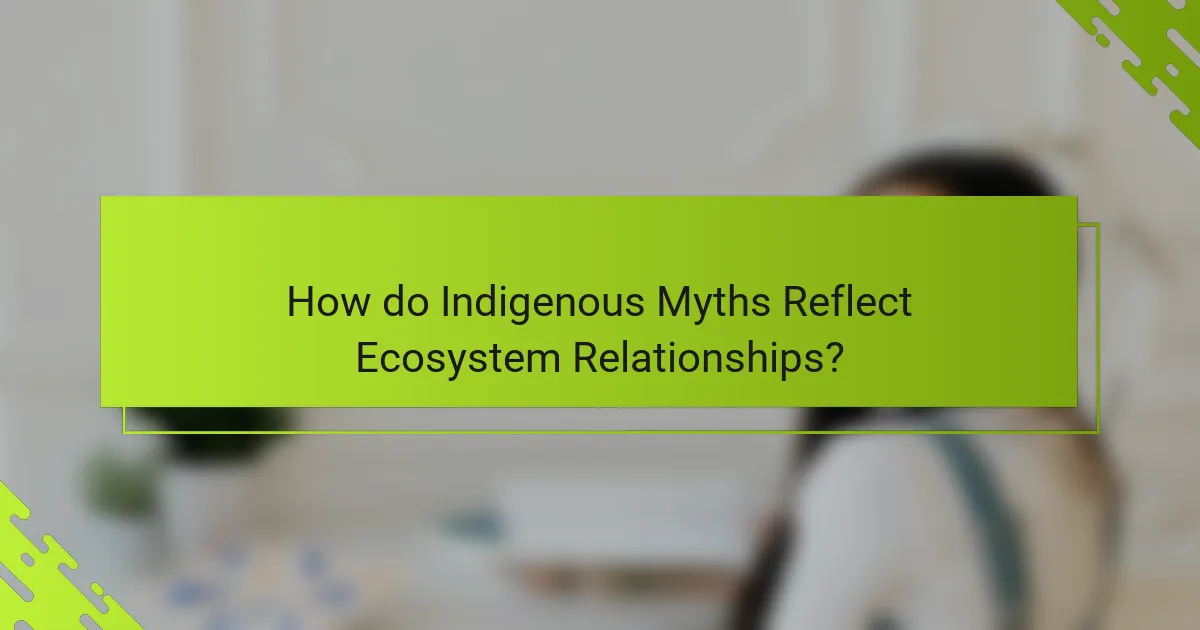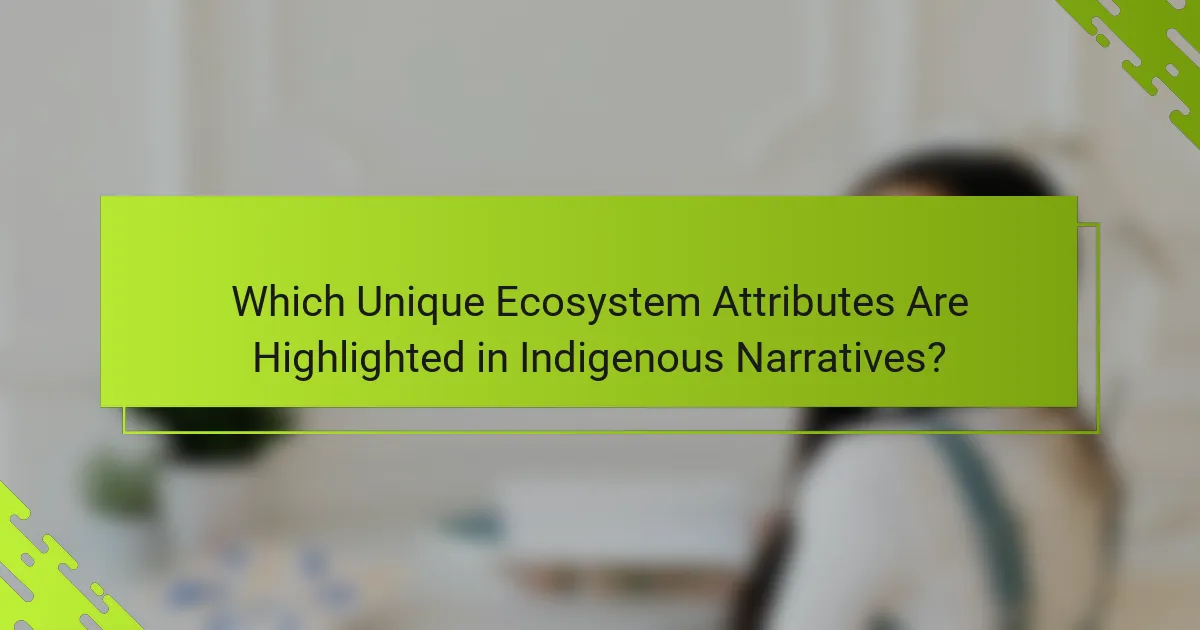Understanding the interconnection of Indigenous myths and ecosystems reveals vital insights into environmental stewardship. These narratives emphasize the balance between humanity and nature, showcasing sustainable practices. They also serve as historical records of ecological changes and highlight the role of traditional knowledge in resource management. Addressing modern challenges is essential to preserve these narratives and their contributions to biodiversity and cultural identity.

How do Indigenous Myths Reflect Ecosystem Relationships?
Indigenous myths reflect ecosystem relationships by illustrating the interconnectedness of nature and culture. These narratives often emphasize the balance between human beings and their environment, showcasing how natural elements influence daily life.
For instance, many myths personify animals and plants, attributing them with wisdom and agency. Such representations encourage respect and stewardship of the land. Indigenous stories frequently highlight sustainable practices, demonstrating a deep understanding of ecological principles.
Moreover, these myths can serve as historical records of environmental changes. They provide insights into how ecosystems have evolved and how communities have adapted. This rich tapestry of stories fosters a sense of identity and responsibility towards the natural world.
What are the common themes found in Indigenous myths related to nature?
Indigenous myths commonly emphasize themes of harmony, respect, and reciprocity with nature. These narratives often illustrate the interconnectedness of all living beings and the environment. They highlight the importance of maintaining balance within ecosystems and the consequences of disrupting this harmony. Myths frequently feature animals and natural elements as central characters, symbolizing lessons about sustainability and stewardship. Additionally, many stories convey a deep spiritual connection to the land, reflecting unique cultural values and practices that promote ecological awareness.
How do these myths influence environmental stewardship?
Indigenous myths significantly influence environmental stewardship by fostering a deep respect for nature. These narratives often embody ecological wisdom, promoting sustainable practices and a sense of responsibility towards ecosystems. For example, stories that highlight the interconnectedness of all living beings encourage communities to protect their natural surroundings. This cultural perspective nurtures a stewardship ethic, guiding actions that prioritize ecological balance and conservation. As a result, indigenous beliefs serve as a powerful framework for modern environmental efforts, emphasizing the importance of harmony with nature.
Which ecosystems are most frequently represented in Indigenous storytelling?
Indigenous storytelling frequently represents ecosystems such as forests, rivers, mountains, and deserts. These ecosystems embody cultural values, spiritual beliefs, and survival practices. For instance, forests symbolize life and interconnectedness, while rivers often represent journeys and transformation. Indigenous narratives highlight the unique attributes of these ecosystems, emphasizing their roles in sustaining communities and traditions. Additionally, specific stories may focus on rare species or natural phenomena, illustrating the deep relationship between Indigenous peoples and their environments.

What Role Do Specific Cultural Practices Play in Ecosystem Management?
Specific cultural practices significantly enhance ecosystem management by integrating traditional ecological knowledge. Indigenous myths often embody sustainable practices that promote biodiversity and resource conservation. These narratives guide community behaviors, fostering respect for natural resources. For example, certain myths may emphasize seasonal rituals that align with local ecological conditions, ensuring sustainable harvesting. This interconnection illustrates how cultural practices can lead to effective ecosystem stewardship, demonstrating the value of indigenous wisdom in contemporary environmental management.
How do traditional ecological knowledge systems enhance biodiversity?
Traditional ecological knowledge systems enhance biodiversity by integrating cultural practices with environmental stewardship. Indigenous myths often convey ecological principles, promoting sustainable resource management. These narratives emphasize the interconnectedness of species and habitats, fostering respect for natural systems. As a result, biodiversity is preserved through practices that align with ecological balance.
What are the rituals associated with seasonal changes in different Indigenous cultures?
Indigenous cultures have diverse rituals that reflect their connection to seasonal changes. These rituals often celebrate the cycles of nature and are integral to their cultural identity.
Many Indigenous communities perform seasonal ceremonies that align with agricultural practices. For example, spring rituals may involve planting songs and dances to ensure a bountiful harvest. In contrast, autumn ceremonies often focus on gratitude and the gathering of crops.
Unique attributes of these rituals include the use of specific symbols and storytelling traditions that convey ecological knowledge. Rarely, some cultures may incorporate elements like animal migrations or celestial events to mark seasonal transitions.
Overall, these rituals illustrate the deep interconnection between Indigenous myths and ecosystems, reinforcing the importance of environmental stewardship.

Which Unique Ecosystem Attributes Are Highlighted in Indigenous Narratives?
Indigenous narratives highlight unique ecosystem attributes such as interconnectedness, sustainability, and respect for nature. These stories often emphasize the role of specific species, seasonal changes, and natural events in maintaining ecological balance. They illustrate the deep relationship between culture and environment, showcasing how traditional knowledge informs conservation practices. For example, many Indigenous myths feature animals as central figures, symbolizing ecological roles and interdependence within ecosystems.
How do specific species feature in Indigenous myths and their ecological significance?
Indigenous myths often feature specific species that embody cultural values and ecological wisdom. These narratives highlight the interconnectedness of humans and nature, emphasizing the importance of biodiversity.
For instance, the coyote in many Native American traditions represents adaptability and survival, reflecting its ecological role as a scavenger and predator. Similarly, the salmon in Pacific Northwest cultures symbolizes abundance and the cyclical nature of life, directly linking to its migratory patterns and ecological significance in sustaining ecosystems.
These myths serve as a means of transmitting ecological knowledge, teaching communities about sustainable practices and the respect needed for the environment. By integrating species into their stories, Indigenous cultures reinforce the idea that all life forms are interconnected, fostering a sense of stewardship towards the land and its resources.
What are the unique environmental practices of select Indigenous communities?
Indigenous communities practice unique environmental methods that reflect their deep connection to ecosystems. These practices include sustainable land management, traditional ecological knowledge, and rituals that honor nature.
For example, the Navajo use rotational grazing to prevent overgrazing, which maintains soil health. The Māori of New Zealand emphasize the concept of “kaitiakitanga,” or guardianship, ensuring that natural resources are preserved for future generations.
Additionally, many Indigenous groups conduct controlled burns to promote biodiversity and reduce wildfire risks. These practices demonstrate a profound understanding of ecological balance and sustainability.
Overall, the environmental practices of Indigenous communities illustrate their commitment to preserving ecosystems through culturally significant methods.

In What Ways Do Modern Challenges Affect Indigenous Ecosystem Narratives?
Modern challenges significantly disrupt Indigenous ecosystem narratives by altering traditional practices, disrupting oral histories, and diminishing biodiversity. Climate change, industrialization, and land encroachment threaten the very ecosystems that Indigenous myths often celebrate and protect. As a result, these narratives struggle to adapt to the rapid environmental changes, leading to a loss of cultural identity and heritage. Furthermore, the unique relationship between Indigenous communities and their ecosystems is increasingly strained, as external pressures undermine the sustainability of these vital narratives.
How has climate change impacted the stories and practices of Indigenous groups?
Climate change has significantly altered Indigenous stories and practices, impacting their cultural narratives and ecological knowledge. Many Indigenous groups rely on traditional ecological knowledge, which reflects their deep connection to the environment. As climate change affects ecosystems, it disrupts these narratives, leading to the loss of species and changes in landscapes that are central to their myths.
For example, the shifting migration patterns of animals can alter hunting practices, which are often tied to specific stories and rituals. Additionally, changing weather patterns influence agricultural practices and seasonal celebrations, leading to adaptations in how these communities interact with their environment.
These transformations highlight the unique attribute of Indigenous resilience, as communities strive to maintain their cultural identity amid environmental challenges. The rare occurrence of climate-induced phenomena, such as droughts or floods, further emphasizes the urgency of preserving these narratives and practices for future generations.
What are the implications of urbanization on Indigenous mythologies and ecosystems?
Urbanization disrupts Indigenous mythologies and ecosystems by altering landscapes and diminishing cultural connections. Rapid development often leads to habitat destruction, impacting biodiversity and traditional practices. Indigenous narratives, deeply tied to specific ecosystems, face erosion as urban growth replaces natural environments. This loss threatens the transmission of cultural knowledge and the spiritual significance of land, leading to a disconnection from ancestral wisdom. As a result, urbanization not only challenges ecological balance but also undermines the rich tapestry of Indigenous identities and their relationship with nature.

Why is the Interconnection of Myths and Ecosystems Vital for Future Sustainability?
The interconnection of indigenous myths and ecosystems is vital for future sustainability because these myths offer valuable insights into environmental stewardship. They emphasize respect for nature and highlight the importance of biodiversity. Indigenous narratives often convey lessons about resource management and the consequences of ecological imbalance. As a result, integrating these perspectives can enhance modern sustainability practices, fostering a deeper understanding of our relationship with the environment. This approach not only preserves cultural heritage but also promotes ecological resilience.
How can Indigenous wisdom contribute to contemporary environmental solutions?
Indigenous wisdom can significantly enhance contemporary environmental solutions by emphasizing holistic approaches. These traditions often view ecosystems as interconnected, fostering sustainable practices that respect natural balances. For example, Indigenous land management techniques, such as controlled burns, promote biodiversity and reduce wildfire risks.
Additionally, Indigenous myths often convey deep ecological knowledge, illustrating the importance of preserving natural resources. This unique attribute of storytelling can inspire modern conservation efforts by highlighting the consequences of environmental degradation.
As a result, integrating Indigenous perspectives into environmental policies can provide innovative strategies that align with ecological sustainability. By valuing these insights, society can work towards more effective and culturally respectful environmental solutions.
What are the best practices for integrating Indigenous knowledge into modern conservation efforts?
Integrating Indigenous knowledge into modern conservation efforts requires collaboration, respect, and recognition of traditional practices. Engaging Indigenous communities fosters sustainable ecological management and enhances biodiversity conservation.
Best practices include:
1. Establishing partnerships with Indigenous groups to co-create conservation strategies.
2. Incorporating traditional ecological knowledge in land management plans.
3. Providing platforms for Indigenous voices in decision-making processes.
4. Ensuring equitable sharing of benefits derived from natural resources.
5. Promoting education and awareness about Indigenous cultural practices related to ecosystems.
6. Recognizing and protecting Indigenous land rights to support conservation goals.
What common mistakes should be avoided in the representation of Indigenous narratives in ecological contexts?
To effectively represent Indigenous narratives in ecological contexts, avoid oversimplification, cultural appropriation, and misrepresentation. These mistakes can distort the intricate relationships between Indigenous peoples and their ecosystems.
Oversimplification reduces complex narratives to mere stereotypes, stripping them of their cultural significance. Cultural appropriation involves taking Indigenous stories without permission, undermining their authenticity. Misrepresentation can occur when narratives are presented without proper context, leading to misunderstandings about Indigenous beliefs and practices.
Additionally, neglecting to include Indigenous voices in the storytelling process can perpetuate inaccuracies. Engaging with Indigenous communities ensures that narratives reflect their perspectives and experiences accurately. This collaborative approach honors the unique attributes of Indigenous knowledge systems and their ecological insights.
